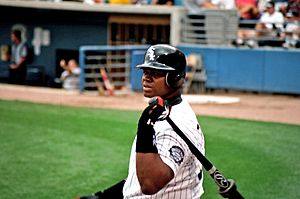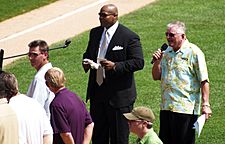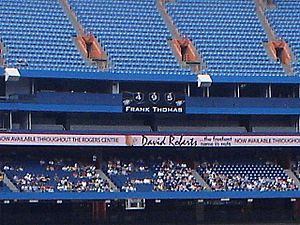Frank Thomas (designated hitter) facts for kids
Quick facts for kids Frank Thomas |
|||
|---|---|---|---|
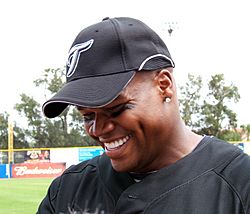
Thomas with the Toronto Blue Jays in 2008
|
|||
| Designated hitter / First baseman | |||
| Born: May 27, 1968 Columbus, Georgia, U.S. |
|||
|
|||
| debut | |||
| August 2, 1990, for the Chicago White Sox | |||
| Last appearance | |||
| August 29, 2008, for the Oakland Athletics | |||
| MLB statistics | |||
| Batting average | .301 | ||
| Hits | 2,468 | ||
| Home runs | 521 | ||
| Runs batted in | 1,704 | ||
| Teams | |||
|
|||
| Career highlights and awards | |||
|
|||
| Induction | 2014 | ||
| Vote | 83.7% (first ballot) | ||
Frank Edward Thomas Jr. (born May 27, 1968) is a former American professional baseball player. He was known as "the Big Hurt." Frank played as a designated hitter and first baseman in Major League Baseball (MLB). He played for three teams in the American League (AL) from 1990 to 2008. Most of his career was with the Chicago White Sox.
Frank Thomas was a five-time All-Star. He is the only player in MLB history to have seven years in a row (1991–1997) with amazing stats. In each of those years, he had a batting average of at least .300, 100 runs batted in (RBI), 100 runs scored, 100 walks, and 20 home runs. In 1997, Thomas also won the AL batting title with a .347 average. He won the AL MVP award twice. In 2005, his team won the World Series, even though he was injured. Many people think Frank Thomas is one of the best right-handed hitters ever in MLB.
Contents
Early Life and College Baseball
Frank Thomas was born and grew up in Columbus, Georgia. He went to Columbus High School. There, he was a great player in both football and baseball. In his second year, he helped his baseball team win a state championship. As a senior, he hit .440 in baseball. He was also an All-State tight end in football. He also played forward on the basketball team.
Frank really wanted to play professional baseball. But he was not picked in the 1986 draft. He felt "shocked and sad" because other players he knew were drafted.
In 1986, Thomas got a scholarship to play football at Auburn University. But he loved baseball more. The baseball coach at Auburn, Hal Baird, saw his talent right away. Frank was a great hitter. As a freshman, he hit .359 and led the Tigers in RBIs.
In the summer of 1987, he played for the U.S. Pan American Team. He made the team for the 1987 Pan American Games. But he left the team to go back to Auburn for football practice. He got injured twice in early football games. After that, baseball became his only sport.
In 1988, Thomas played for the Orleans Cardinals in the Cape Cod Baseball League. He hit three home runs in one game. He also hit a very long home run over the 434-foot sign in center field. In 2000, he was put into the Cape Cod Baseball League Hall of Fame.
By the end of his junior year in college, he had hit 19 home runs and 19 doubles. He batted .403 with a slugging percentage of .801. Frank finished his college career with 49 home runs, which was a school record. In 2011, he was put into the Alabama Sports Hall of Fame.
Professional Baseball Career
Chicago White Sox Years
Starting Strong (1990–1996)
The Chicago White Sox picked Frank Thomas seventh overall in the 1989 MLB draft. He played his first major league game on August 2, 1990. He didn't get a hit that day, but he did get an RBI. On August 28, Frank hit his first career home run. It was against the Minnesota Twins. He played 60 games in 1990, hitting .330 with seven home runs and 31 RBIs.
Frank Thomas became known for his powerful home runs. In his first full season in 1991, he showed he was a great all-around hitter. He hit for average, got power, drew walks, and drove in runs. He finished third in the MVP voting. He hit .318 with 32 home runs and 109 RBIs. He also had 138 walks. He won his first Silver Slugger Award. He led the league in on-base percentage.
In 1993, Thomas hit .317 with a team-record 41 home runs. He also had 128 RBIs, 106 runs scored, and 112 walks. He became one of only a few players in history to hit over .300 with more than 20 homers, 100 RBIs, 100 runs, and 100 walks for three years in a row. Frank won the AL Most Valuable Player award. All 28 baseball writers voted for him. He led the White Sox to win their division. His manager, Gene Lamont, said Frank could hit any pitch. White Sox announcer Ken Harrelson gave him the nickname "Big Hurt."
In 1994, the season was shorter because of a players' strike. But Thomas still had huge numbers. He hit .353 with 38 home runs and 101 RBIs. He led the league in runs scored (106), walks (109), and slugging percentage (.729). Thomas easily won his second straight MVP award. He is one of only three first basemen to win two MVP awards in a row.
The strike in 1994 stopped Thomas from possibly winning the Major League Baseball Triple Crown. This means leading the league in batting average, home runs, and RBIs. No one had done this since 1967. Thomas had 32 home runs by the All-Star break.
Frank kept putting up great numbers. In 1995, he hit .308 with 40 homers and 111 RBIs. In 1996, he hit .349 with 40 home runs and 134 RBIs. He was an All-Star for the fourth time.
Later Years and Injuries (1997–2005)
From 1991 to 1997, Frank Thomas was always one of the top players in MVP voting. In 1997, he won the batting title. He finished third in MVP voting. Thomas was not known for his defense at first base. He preferred playing in the field to being a designated hitter. He felt it helped him focus. But by the late 1990s, small injuries often kept him from playing. After 1997, he played more as a designated hitter.
In 2000, Thomas came back strong. He hit .328 with a career-high 43 home runs and 143 RBIs. He finished second in MVP voting. He also won the AL Comeback Player of the Year Award. The White Sox had the best record in the AL that year.
In 2001, Frank's father passed away. In the same week, Frank found out he needed surgery on his arm. He only played 20 games that year. He hit just .221 with four home runs. He was very sad about losing his father and his season.
He came back from his injury in 2002. He played in 148 games. But his batting average dropped to .252. He never hit close to .300 again. However, he still had his power and could get on base. He finished 2002 with 28 home runs and 92 RBIs. Thomas was always good at drawing walks. He led the AL in walks four times.
In 2003, Thomas had another good season. He hit 42 home runs, tied for second in the AL. He was also among the league's top ten in walks and other hitting stats. In 2005, he was injured again. But he still hit 12 home runs in only 35 games. This showed he still had power.
2005 World Series Win
In 2005, the White Sox won the World Series. It was their first win in 88 years. Frank Thomas was not on the team's roster for the playoffs because of his injury. But the team honored him for all his years of contributions. He threw out the first pitch before Game 1 of the Division Series. Frank said it was a great feeling to see the fans cheer for him. He even had tears in his eyes. Even though he didn't play in the postseason, he still received a World Series ring.
Leaving the White Sox (2005)
Frank Thomas holds many White Sox batting records. He is the all-time leader in runs scored (1,327), home runs (448), RBIs (1,465), and many other categories. When he left the team, his 448 home runs were more than double what any other White Sox player had hit.
Even with all his success, the White Sox decided to release Thomas in 2005. Frank was disappointed with how it ended. He felt the team's chairman, Jerry Reinsdorf, should have called him. He also said he didn't get along well with the general manager, Kenny Williams.
Oakland Athletics (2006)
On January 26, 2006, Thomas signed a one-year contract with the Oakland Athletics. He became their everyday designated hitter. He started the season slowly. But he ended up leading the team in home runs, RBIs, and other hitting stats. He was a powerful hitter in the middle of their lineup.
On May 22, 2006, Thomas hit two home runs in his first game against his old team, the White Sox. The White Sox fans cheered him when he was introduced. When he hit his first home run, the crowd gave him a standing ovation.
Frank Thomas had a great season with the Athletics. He hit 39 home runs and 114 RBIs. He helped the team reach the playoffs. On October 3, he hit two solo home runs in his first playoff game since 2000. This made him the oldest player to hit multiple home runs in a playoff game. He helped the A's win their first playoff series. But they lost in the next round.
Toronto Blue Jays (2007–2008)
On November 16, 2006, Thomas signed a two-year contract with the Toronto Blue Jays. On June 17, 2007, he hit his 496th career home run. This broke the record for most home runs by a designated hitter.
On June 28, 2007, Frank Thomas hit his 500th career home run. He became the 21st player in MLB history to do this. It was a three-run home run against Carlos Silva of the Minnesota Twins. This happened in the same stadium where he hit his first career home run.
On September 17, 2007, Thomas hit three home runs in one game against the Boston Red Sox. It was the second time in his career he hit three homers in a game.
In April 2008, the Blue Jays benched Thomas. He was upset and said his career would "not end like this." On April 20, 2008, the Blue Jays released him.
Return to Oakland (2008)
Four days after being released by Toronto, Frank Thomas rejoined the Oakland Athletics. He played 55 games with Oakland. He hit five more home runs, bringing his career total to 521. He became a free agent on October 31, 2008.
Retirement with Chicago
 |
|
| Frank Thomas's number 35 was retired by the Chicago White Sox in 2010. |
Frank Thomas did not play in the 2009 season. On February 12, 2010, he signed a one-day contract with the White Sox and announced his retirement. The White Sox also announced they would retire his uniform number 35 on August 29.
Frank Thomas is the only player in MLB history to have seven years in a row with a .300 average, 100 walks, 100 runs, 100 RBIs, and 20 home runs (1991–1997). Only Ted Williams has done this for more than five years in a row (he did it for six). This is even more amazing because the 1994 season was shortened by a strike.
Only six other players in history have hit more home runs and have a higher career batting average than Thomas. These players are Ted Williams, Hank Aaron, Jimmie Foxx, Babe Ruth, Manny Ramirez, and Willie Mays.
Playing Achievements
- Five-time All-Star (1993–1997)
- Four-time Silver Slugger Award winner (1991, 1993–1994, 2000)
- On June 28, 2007, Thomas became the 21st player in MLB history to hit at least 500 home runs.
- Thomas is one of only a few players to hit 500 home runs and keep a career .300 batting average.
- He is also one of only a few players to hit 500 career home runs and have at least 1,600 walks.
- Thomas was the first player in MLB history to win two Silver Slugger Awards at two different positions.
- He was only the 11th player in history to win two Most Valuable Player Awards in a row.
- His 138 walks in 1991 were the most by any American League player in the 1990s.
- His .729 slugging average in the shortened 1994 season was the highest for an AL player since 1957.
- In 1994, Thomas had an on-base percentage of .494, which was also the highest for an AL player since 1957.
- He retired as the all-time leader in home runs by a designated hitter (269). David Ortiz later broke this record.
- He is the only player in MLB history to hit over 100 sacrifice flies and never have a single sacrifice bunt.
- The White Sox retired his uniform number 35 on August 29, 2010.
After Baseball
Honors
The White Sox announced they would honor Thomas with a life-size bronze statue. It was shown on July 31, 2011, at U.S. Cellular Field. It is the eighth statue there.
Frank Thomas was elected to the National Baseball Hall of Fame in 2014. He was chosen in his first year of being eligible. He was inducted as a member of the White Sox on July 27, 2014. He was the first player inducted who played more games as a designated hitter than as a position player.
Media Appearances
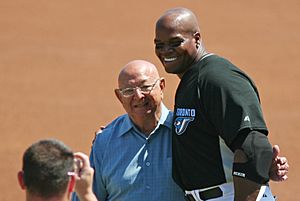
Thomas was in the 1992 movie Mr. Baseball. He played a rookie named Ricky Davis.
In 1995, a baseball video game called Frank Thomas Big Hurt Baseball was made. Another game, All-Star Baseball '97 Featuring Frank Thomas, followed in 1997. Also in 1995, a pinball machine called Frank Thomas' Big Hurt was created.
In 2007, he was in a funny advertisement for the Blue Jays. He had a pillow fight with children.
Broadcasting Career
Thomas was a guest analyst for TBS during the 2007 MLB playoffs.
Since 2010, Thomas has appeared on NBC Sports Chicago. He is a studio analyst for White Sox games. He also sometimes fills in as a color analyst for White Sox broadcasts.
In 2014, Thomas joined Fox Sports as a studio analyst for MLB on Fox. In June 2023, he joined Apple TV+'s Friday Night Baseball as an interviewer and commentator.
Business Ventures
Thomas is the CEO and Founder of W2W Records, a record label. He also started his own microbrew called Big Hurt Beer in 2011.
In November 2014, Thomas opened a brewpub called Big Hurt Brewhouse. It closed in 2016 but reopened as 35 Sports Bar and Grill. It closed for good in 2018.
In 2018, Thomas became a spokesperson for Guaranteed Rate, a mortgage company. This company also has the naming rights to the White Sox stadium.
In 2021, Frank Thomas bought a big part of Field of Dreams in Iowa.
- DHL Hometown Heroes
- 500 home run club
- List of Major League Baseball career home run leaders
- List of Major League Baseball career hits leaders
- List of Major League Baseball career runs batted in leaders
- List of Major League Baseball batting champions
See also
 In Spanish: Frank Thomas (beisbolista nacido en 1968) para niños
In Spanish: Frank Thomas (beisbolista nacido en 1968) para niños


